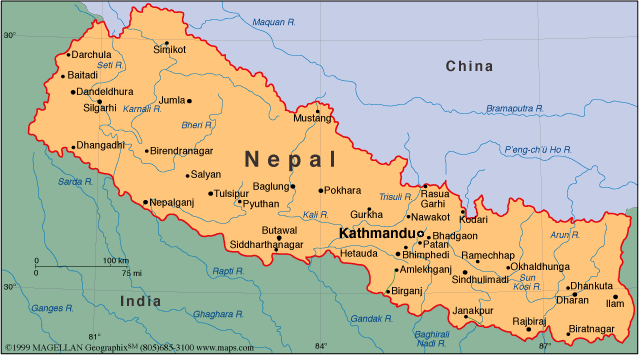After A Revolution
Post Civil War Nepal
Nepal: An Overview

The Federal Democratic Republic of Nepal is a sovereign landlocked country located in South Asia between India and China. With an area of 147,181 square kilometers (56,827 sq mi) and a population of approximately 27 million (and nearly 2 million absentee workers living abroad),Nepal is the world's 93rd largest country by land mass and the 41st most populous country.
Kathmandu is the capital and largest city of Nepal. Nepali is the official language but more than 103 languages are spoken by people of different ethnic backgrounds. Situated in the lap of the Himalayas, Nepal has eight of the tallest peaks in the world, including Mount
Everest. Hinduism, Buddhism, Islam, Kirat and Christianity are the main religions of Nepal.
Since its foundation as a formal Kingdom in 1768 by Prithivi Narayan Shah, Nepal was ruled by a monarchy system lead by the Shah Dynasty. But in 2006, Nepal became a federal republic after a decade of civil war. Though there have been efforts to create a new constitution and hold democratic elections, prevailing political impasse between the major parties has led to more social tensions and economic problems.
The Federal Democratic Republic of Nepal is a sovereign landlocked country located in South Asia between India and China. With an area of 147,181 square kilometers (56,827 sq mi) and a population of approximately 27 million (and nearly 2 million absentee workers living abroad),Nepal is the world's 93rd largest country by land mass and the 41st most populous country.
Kathmandu is the capital and largest city of Nepal. Nepali is the official language but more than 103 languages are spoken by people of different ethnic backgrounds. Situated in the lap of the Himalayas, Nepal has eight of the tallest peaks in the world, including Mount
Everest. Hinduism, Buddhism, Islam, Kirat and Christianity are the main religions of Nepal.
Since its foundation as a formal Kingdom in 1768 by Prithivi Narayan Shah, Nepal was ruled by a monarchy system lead by the Shah Dynasty. But in 2006, Nepal became a federal republic after a decade of civil war. Though there have been efforts to create a new constitution and hold democratic elections, prevailing political impasse between the major parties has led to more social tensions and economic problems.


